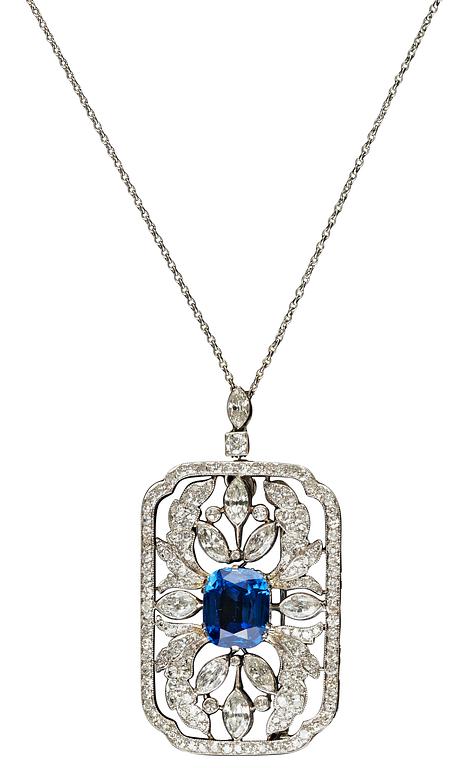A W.A. Bolin platinum, blue sapphire, app. 4.60 cts, and diamond pendant/brooch, tot. 4.69 cts. Stockholm 1930.
9 navette cut diamonds, tot. 1.96 cts, eight cut diamonds, tot. 2.73 cts. Total l. 5 cm. Length of the chain 68 cm. Original box.
Provenance
Gift from Axel Krüger to Greta Krüger 23rd of September 1931.
More information
Carl Edvard Bolin arrived in St Petersburg in 1833 and began working for Andreas Roempler, an already well established jeweller. In 1834, when marrying Ernestine Catharina, a daughter of the recently deceased Roempler, Carl Edvard became a full partner of the business. In 1839 the partners submitted a request to become Jewelers to the Imperial Court, which was granted.
Bolin, a successfull businessman, rapidly bacame the most important jeweler in St. Petersburg. At the peak if his activity he supplied more to the Imperial Court than all the other jewelers put together. Towards the end of the 19th century some of the leading Paris houses, particularly Boucheron, established themselves in Russia, becoming big competitors to the Bolin company and were granted impressive commissions.
From the 1890's Bolin's main competitor was Fabergé, who finally surpassed Bolin in numbers and possibly also in turnover, of pieces of jewelry made for the Court.
Carl Edvard Bolin had died in St. Petersburg 1864, leaving his part of the firm to his sons Gustaf and Edward. Carl Edvards brother, Henrik Conrad, opened a shop in Moscow in 1852, which was taken over by his eldest son Wilhelm Bolin. The Moscow shop was taken over in his own name in 1912, W.A Bolin.
In St. Petersburg, the two brothers, Carl and Edward, continued as one of the foremost jewelry houses. Sadly, when Gustaf Bolin died in 1916 neither he or his brother Edward had any heirs wishing to take over the business. Wilhelm Bolin, in Moscow, who had two sons, was interested but unfortunately the Russian revolution put an end to such plans.
At the outbreak of the World War I, Wilhelm Bolin, whose Russian belongings and assets were confiscated by the Bolsheviks, transferred his German stock (where a branch office in Bad Homburg had been opened in 1912) to Stockholm, where he opened a shop in 1916.
W.A. Bolin still exists today and is one of the few old jewellery houses still remaining in the family name. It has maintained its reputation of high quality jewellry and exquisite workmanship.
Observation of small rutile inclusions indicates natural blue colour of the sapphire.





































